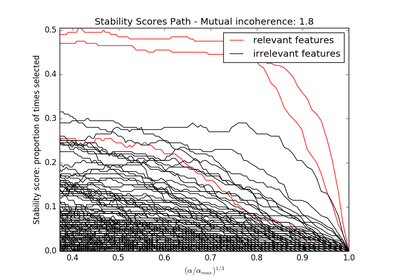sklearn.linear_model.lasso_stability_path¶
-
sklearn.linear_model.lasso_stability_path(X, y, scaling=0.5, random_state=None, n_resampling=200, n_grid=100, sample_fraction=0.75, eps=8.8817841970012523e-16, n_jobs=1, verbose=False)[源代码]¶ Stabiliy path based on randomized Lasso estimates
Read more in the User Guide.
Parameters: X : array-like, shape = [n_samples, n_features]
training data.
y : array-like, shape = [n_samples]
target values.
scaling : float, optional, default=0.5
The alpha parameter in the stability selection article used to randomly scale the features. Should be between 0 and 1.
random_state : integer or numpy.random.RandomState, optional
The generator used to randomize the design.
n_resampling : int, optional, default=200
Number of randomized models.
n_grid : int, optional, default=100
Number of grid points. The path is linearly reinterpolated on a grid between 0 and 1 before computing the scores.
sample_fraction : float, optional, default=0.75
The fraction of samples to be used in each randomized design. Should be between 0 and 1. If 1, all samples are used.
eps : float, optional
Smallest value of alpha / alpha_max considered
n_jobs : integer, optional
Number of CPUs to use during the resampling. If ‘-1’, use all the CPUs
verbose : boolean or integer, optional
Sets the verbosity amount
Returns: alphas_grid : array, shape ~ [n_grid]
The grid points between 0 and 1: alpha/alpha_max
scores_path : array, shape = [n_features, n_grid]
The scores for each feature along the path.
Notes
See examples/linear_model/plot_sparse_recovery.py for an example.


